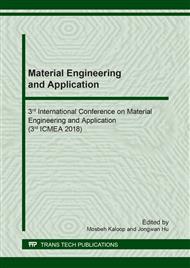[1]
A. Bonifacio, S. Dalla Marta, R. Spizzo, S. Cervo, A. Steffan, A. Colombatti, V. Sergo, Surface-enhanced Raman spectroscopy of blood plasma and serum using Ag and Au nanoparticles: a systematic study, Anal. Bioanal. Chem. 406(9-10) (2014).
DOI: 10.1007/s00216-014-7622-1
Google Scholar
[2]
Y. Fang, N. H. Seong, D. D. Dlott, Measurment of the distribution of site enhancements in surface-enhanced Raman scattering, Sci. 321(5887) (2008) 388-392.
DOI: 10.1126/science.1159499
Google Scholar
[3]
K. A. Willets, Surface-enhanced Raman scattering (SERS) for probing internal cellular structure and dynamics, Anal. Bioanal. Chem. 394(1) (2009) 85-94.
DOI: 10.1007/s00216-009-2682-3
Google Scholar
[4]
J. I. Gersten, The effect of surface roughness on surface enhanced Raman scattering, J. Chem. Phys. 72(10) (1980) 5779-5780.
DOI: 10.1063/1.439002
Google Scholar
[5]
M. E. Hankus, H. Li, G. J. Gibson, B. M. Cullum, Surface-enhanced Raman scattering-based nanoprobe for high-resolution, non-scanning chemical imaging, Anal. Chem. 78(21) (2006) 7535-7546.
DOI: 10.1021/ac061125a
Google Scholar
[6]
D. Seo, C. I. Yoo, I. S. Chung, S. M. Park, S. Ryu, H. J. Song, Shape adjustment between multiply twinned and single-crystalline polyhedral gold nanocrystals: decahedra, icosahedra, and truncated tetrahedral, J. Phys. Chem. C 112(7) (2008).
DOI: 10.1021/jp7109498.s002
Google Scholar
[7]
J. Verma, H. A. Van Veen, S. Lal, C. J. F. Van Noorden, Wet Chemistry Approaches for Synthesis of Gold Nanospheres, Nanorods and Nanostars, Curr. Nanosci. 10(5) (2014) 660-669.
DOI: 10.2174/1573413710666140526232421
Google Scholar
[8]
H. K. Yuan, C. G. Khoury, C. M. Wilson, G. A. Grant, A. J. Bennett, T. Vo-Dinh, In vivo particle tracking and photothermal ablation using plasmon-resonant gold nanostars, Nanomed-Nanotechnol. Biol. Med. 8(8) (2012) 1355-1363.
DOI: 10.1016/j.nano.2012.02.005
Google Scholar
[9]
C. Hrelescu, T. K. Sau, A. L. Rogach, F. Jaekel, G. Laurent, L. Douillard, F. Charra, Selective excitation of individual plasmonics hotspots at the tips of single gold nanostars, Nano Lett. 11(2) (2011) 402-407.
DOI: 10.1021/nl103007m
Google Scholar
[10]
X. Han, D. Wang, J. Huang, D. Liu, T. You, Ultrafast growth of dendritic gold nanostructures and their applications in methanol electro-oxidation and surface-enhanced Raman scattering, J. Colloid Interf. Sci. 354(2) (2011) 577-584.
DOI: 10.1016/j.jcis.2010.11.045
Google Scholar
[11]
Q. Su, X. Ma, J. Dong, C. Jiang, W. Qian, A Reproducible SERS Substrate Based on Electrostatically Assisted APTES-Functionalized Surface-Assembly of Gold Nanostars, ACS Appl. Mater. Interf. 3(6) (2011) 1873-1879.
DOI: 10.1021/am200057f
Google Scholar
[12]
M. Li, S. K. Cushing, J. Zhang, J. Lankford, Z. P. Aguilar, D. Ma, and N. Q. Wu, Shape-dependent surface-enhanced Raman scattering in gold-Ramanprobe-silica sandwiched nanoparticles for biocompatible applications, Nanotech. 23(11) (2012) 115501.
DOI: 10.1088/0957-4484/23/11/115501
Google Scholar


